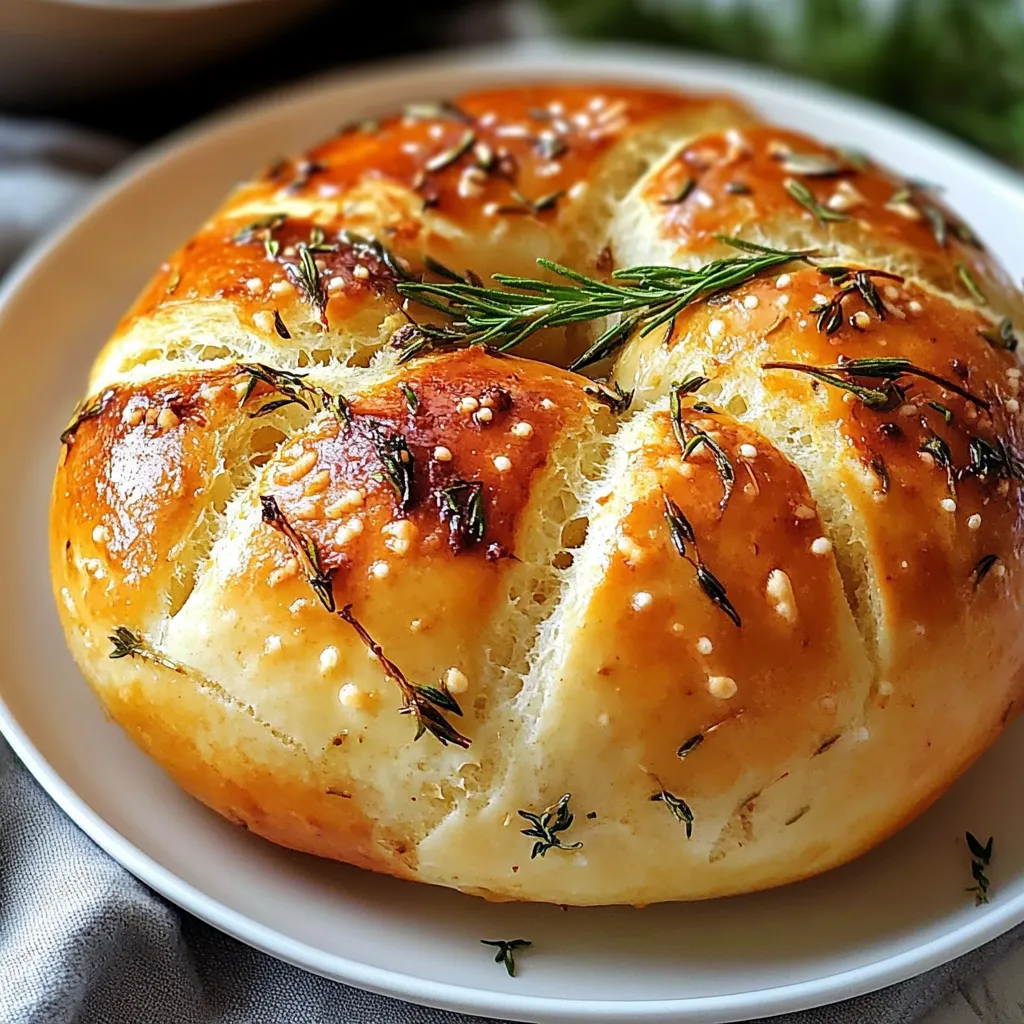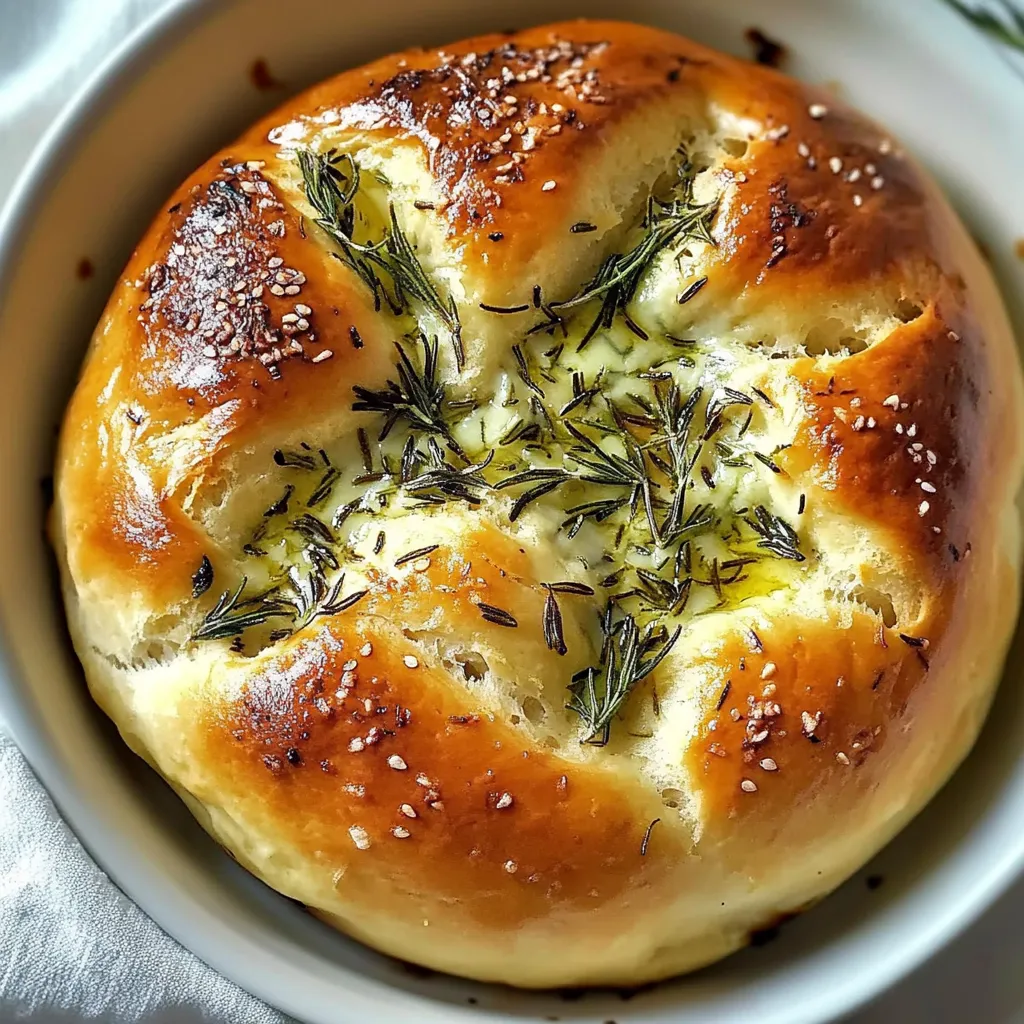 Pin it
Pin it
This rustic no-knead garlic rosemary bread transforms simple ingredients into a bakery-quality loaf with minimal effort. The long fermentation creates a perfect chewy interior with a crackling crust, while aromatic garlic and rosemary infuse every bite with Mediterranean flavor.
I first made this bread during lockdown when store shelves were empty and yeast was scarce. That single loaf sparked a home baking obsession that transformed our family meals forever.
Ingredients
- All purpose flour: Provides the perfect structure for this rustic loaf. Choose unbleached for a slightly better flavor
- Fresh rosemary: Delivers aromatic pine notes that perfume the entire kitchen while baking
- Minced garlic: Infuses the dough with savory depth that mellows beautifully during baking
- Kosher salt: Enhances all flavors and creates the perfect bread chemistry
- Freshly ground black pepper: Adds subtle warmth and complexity
- Instant yeast: Requires just a small amount for the long fermentation magic
- Room temperature water: Activates the yeast properly
- Cornmeal: Prevents sticking and adds textural interest to the bottom crust
Step-by-Step Instructions
- Mix the Dough:
- Combine flour, minced garlic, chopped rosemary, salt, black pepper, and yeast in a large mixing bowl. The dry mixing distributes the herbs and seasonings evenly before adding liquid. Pour in room temperature water and stir with a wooden spoon or use your hands until a sticky, shaggy dough forms. This takes about 30 seconds. The dough will look rough and uneven which is exactly what you want.
- First Rise:
- Cover the bowl tightly with plastic wrap to prevent the surface from drying out. Let the dough rest at room temperature between 65-75°F for 18-24 hours. This extended fermentation develops complex flavors and creates the perfect texture without kneading. Watch for bubbles to form across the surface of the dough which indicates active fermentation.
- Shape the Dough and Second Rise:
- Lightly oil your cast iron skillet to prevent sticking then dust with cornmeal for a crunchy bottom texture. On a generously floured surface gently scrape out the dough which will be very soft and sticky. With floured hands gently shape it into a round ball using just enough pressure to create surface tension without deflating the bubbles. Place the shaped dough into the prepared skillet seam side down. Cover with a clean kitchen towel and allow to rise at room temperature until visibly puffy and doubled in size about 2 hours.
- Bake and Serve:
- Preheat your oven to 450°F ensuring it reaches full temperature before baking. Place the skillet with risen dough into the hot oven and bake for 30-40 minutes. The bread is done when the crust develops a deep golden brown color and sounds hollow when tapped. Allow the bread to cool in the pan for 10-15 minutes which completes the internal cooking process. Transfer to a cutting board and slice with a serrated knife to enjoy warm.
 Pin it
Pin it
The rosemary in this recipe is truly transformative. I grow my own in a small kitchen herb garden and the difference between freshly snipped rosemary and dried is remarkable. My daughter now helps me harvest the herbs each time we bake this bread creating a wonderful kitchen tradition.
Make Ahead Options
This dough actually improves with time. After the initial 18-24 hour fermentation you can refrigerate the dough for up to 3 days before shaping and baking. The cold temperature slows fermentation while developing even deeper flavor. Simply let the refrigerated dough sit at room temperature for 30 minutes before shaping.
Variations To Try
While the classic garlic and rosemary combination is perfect you can customize this bread with different flavor profiles. Try substituting fresh thyme and lemon zest for a bright citrusy loaf. Alternatively add chopped olives and sun dried tomatoes for a Mediterranean twist. You can even incorporate shredded parmesan cheese into the dough for a savory umami boost.
Perfect Pairing Suggestions
This bread shines alongside hearty soups and stews where its sturdy texture can stand up to dipping. For an elegant appetizer serve warm slices with high quality olive oil and balsamic vinegar for dipping. It also makes incredible grilled cheese sandwiches with sharp cheddar and a touch of Dijon mustard.
 Pin it
Pin it
Transform your everyday ingredients into this bakery-perfect bread. It‘s simple, rustic, and unforgettable.
Frequently Asked Questions
- → Can I use dried rosemary instead of fresh?
Yes, you can substitute dried rosemary, but use only 1 teaspoon instead of 1 tablespoon since dried herbs are more potent. For the best flavor, crush the dried rosemary between your fingers before adding to release its essential oils.
- → Why does this bread need to rise for so long?
The extended 18-24 hour rise allows for natural fermentation, which develops complex flavors and creates the bread's airy texture. This long, slow process eliminates the need for kneading while the yeast and gluten work together to create structure.
- → Do I need a cast iron skillet to make this bread?
While a cast iron skillet provides ideal heat distribution for a crispy crust, you can also use a Dutch oven, ceramic baking dish, or regular baking sheet. Each alternative will produce slightly different crust characteristics.
- → How should I store leftover bread?
Store completely cooled bread in a paper bag or bread box at room temperature for 2-3 days. For longer storage, slice and freeze in an airtight container for up to 3 months. Refresh frozen slices by toasting.
- → Can I add other herbs or ingredients to this bread?
Absolutely! This bread is highly adaptable. Try adding olives, sun-dried tomatoes, grated parmesan, or different herb combinations like thyme or sage. Just be careful with wet ingredients as they may affect the dough consistency.
- → What's the best way to serve this bread?
Serve slightly warm with good quality olive oil and balsamic vinegar for dipping. It also makes excellent garlic toast when sliced, brushed with olive oil, and briefly toasted. The bread pairs wonderfully with soups, stews, and pasta dishes.
